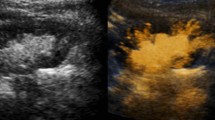Abstract
Voiding urosonography (VUS) using a microbubble contrast agent has been introduced as an alternative technique in the diagnosis of vesicoureteral reflux (VUR). This study was undertaken to assess if phase inversion ultrasound (PIUS), a recent microbubble specific imaging technique, has advantages over fundamental in VUS and if it allows a reduction of contrast agent dose. Forty-three children with suspected VUR (aged 3 days–12 years, average of 3.9 years) with 92 kidney-ureter units (KUU) were included. Everyone obtained a baseline US scan that was followed by VUS using Levovist as the contrast agent. Constant switching between fundamental and PIUS performed the enhanced part for comparison. Every child underwent VCUG immediately afterwards. Contrast enhancement was stronger and longer lasting on PIUS than on fundamental US in all 43 cases. Reflux was detected in a total of 21 KUU, out of 92 KUU (23%). PIUS revealed VUR in 18; fundamental in 14 KUU and VCUG depicted 16 cases of reflux (p≥0.29). The mean volume of Levovist dose administered to the bladder was 7.4±3.4% of the bladder volume. VUS using PI mode provided considerably stronger and longer enhancement and slightly improved the detection of VUR. It allowed a reduction of contrast dose and cost by approximately 35% over current dose recommendations for fundamental US.




Similar content being viewed by others
References
Arant BS Jr (1991) Vesicoureteric reflux and renal injury. Am J Kidney Dis 17:491–511
Belman AB (1995) A perspective on vesicoureteral reflux. Urol Clin North Am 22:139–150
Egghart G, Schlickenrieder JH, Hautmann R (1986) Diagnosis of reflux in children with CO2 and ultrasound. Technic and preliminary results. Urologe A 25:329–332
Alzen G, Wildberger JE, Muller-Leisse C, Deutz FJ (1994) Ultrasound screening of vesico-uretero-renal reflux. Klin Padiatr 206:178–180
DiPietro MA, Blane CE, Zerin JM (1997) Vesicoureteral reflux in older children: concordance of US and voiding cystourethrographic findings. Radiology 205:821–822
Tremewan RN, Bailey RR, Little PJ, Maling TM, Peters TM, Tait JJ (1976) Diagnosis of gross vesico-ureteric reflux using ultrasonography. Br J Urol 48:431–435
Saraga M, Stanicic A, Markovic V (1996) The role of direct radionuclide cystography in evaluation of vesicoureteral reflux. Scand J Urol Nephrol 30:367–371
Darge K, Dutting T, Zieger B, Mohring K, Rohrschneider W, Troger J (1998) Diagnosis of vesicoureteral reflux with echo-enhanced micturition urosonography. Radiologe 38:405–409
Darge K, Troeger J, Duetting T, Zieger B, Rohrschneider W, Moehring K, Weber C, Toenshoff B (1999) Reflux in young patients: comparison of voiding US of the bladder and retrovesical space with echo enhancement versus voiding cystourethrography for diagnosis. Radiology 210:201–207
Darge K (2002) Diagnosis of vesicoureteral reflux with ultrasonography. Pediatr Nephrol 17:52–60
Albrecht T, Hoffmann CW, Schettler S, Overberg A, Ilg M, von Behren PL, Bauer A, Wolf KJ (2000) B-mode enhancement at phase-inversion US with air-based microbubble contrast agent: initial experience in humans. Radiology 216:273–278
Darge K, Bruchelt W, Roessling G, Troeger J (2003) Interaction of normal saline solution with ultrasound contrast medium: significant implication for sonographic diagnosis of vesicoureteral reflux. Eur Radiol 13:213–218
Hofer M (1999) Sono grundkurs. Georg Thieme Verlag, Stuttgart
Whitehouse GH WB (1983) Techniques in diagnostic radiology. Blackwell, Oxford
Lebowitz RL, Olbing H, Parkkulainen KV, Smellie JM, Tamminen-Mobius TE (1985) International system of radiographic grading of vesicoureteric reflux. International reflux study in children. Pediatr Radiol 15:105–109
Fleiss JL (1981) Statistical methods for rates and proportions. Wiley, London
Smellie JM, Normand IC (1975) Bacteriuria, reflux, and renal scarring. Arch Dis Child 50:581–585
Smellie J, Edwards D, Hunter N, Normand IC, Prescod N (1975) Vesico-ureteric reflux and renal scarring. Kidney Int [Suppl 4]:S65–S72
Report of a meeting of physicians at the Hospital for Sick Children GOS (1996) Vesicoureteric reflux: all in the genes? Lancet 348:725–728
Scott JE, Swallow V, Coulthard MG, Lambert HJ, Lee RE (1997) Screening of newborn babies for familial ureteric reflux. Lancet 350:396–400
Noe HN (1996) Screening for reflux—the current status. J Urol 156:1808
Mentzel HJ, Vogt S, John U, Kaiser WA (2002) Voiding urosonography with ultrasonography contrast medium in children. Pediatr Nephrol 17:272–276
Berrocal T, Gaya F, Arjonilla A, Lonergan GJ (2001) Vesicoureteral reflux: diagnosis and grading with echo-enhanced cystosonography versus voiding cystourethrography. Radiology 221:359–365
Darge K, Troeger J (2002) Vesicoureteral reflux grading in contrast-enhanced voiding urosonography. Eur J Radiol 43:122–128
Darge K, Zieger B, Rohrschneider W, Ghods S, Wunsch R, Troeger J (2001) Contrast-enhanced harmonic imaging for the diagnosis of vesicoureteral reflux in pediatric patients. Am J Roentgenol 177:1411–1415
Papadopoulou F, Efremidis SC, Oiconomou A, Badouraki M, Panteleli M, Papachristou F, Soteriou I, Economou A (2002) Cyclic voiding cystourethrography: is vesicoureteral reflux missed with standard voiding cystourethrography? Eur Radiol 12:666–670
Paltiel HJ, Rupich RC, Kiruluta HG (1992) Enhanced detection of vesicoureteral reflux in infants and children with use of cyclic voiding cystourethrography. Radiology 184:753–755
Polito C, Moggio G, La Manna A, Cioce F, Cappabianca S, Di Toro R (2000) Cyclic voiding cystourethrography in the diagnosis of occult vesicoureteric reflux. Pediatr Nephrol 14:39–41
Mate A, Bargiela A, Mosteiro S, Diaz A, Bello MJ (2003) Contrast ultrasound of the urethra in children. Eur Radiol 13:1534–1537
Acknowledgements
We acknowledge Dr. Dr. W. Hopfenmüller at the Dept. of Medical Biometry and Clinical Epidemiology of the Charité, Campus Benjamin Franklin for his help with the statistical analysis.
Author information
Authors and Affiliations
Corresponding author
Rights and permissions
About this article
Cite this article
Kopitzko, A., Cornely, D., Reither, K. et al. Low contrast dose voiding urosonography in children with phase inversion imaging. Eur Radiol 14, 2290–2296 (2004). https://doi.org/10.1007/s00330-004-2369-2
Received:
Revised:
Accepted:
Published:
Issue Date:
DOI: https://doi.org/10.1007/s00330-004-2369-2




